Role for CysJ flavin reductase in molybdenum cofactor-dependent resistance of Escherichia coli to 6-N-hydroxylaminopurine
- PMID: 20118259
- PMCID: PMC2849459
- DOI: 10.1128/JB.01438-09
Role for CysJ flavin reductase in molybdenum cofactor-dependent resistance of Escherichia coli to 6-N-hydroxylaminopurine
Abstract
We have previously described a novel Escherichia coli detoxification system for the removal of toxic and mutagenic N-hydroxylated nucleobases and related compounds that requires the molybdenum cofactor. Two subpathways (ycbX and yiiM) were identified, each employing a novel molybdo activity capable of inactivating N-hydroxylated compounds by reduction to the corresponding amine. In the present study, we identify the cysJ gene product as one additional component of this system. While the CysJ protein has been identified as the NADPH:flavin oxidoreductase component of the CysJI sulfite reductase complex (CysJ(8)I(4)), we show that the role of CysJ in base analog detoxification is unique and independent of CysI and sulfite reductase. We further show that CysJ functions as a specific partner of the YcbX molybdoenzyme. We postulate that the function of CysJ in this pathway is to provide, via its NADPH:flavin reductase activity, the reducing equivalents needed for the detoxification reaction at the YcbX molybdocenter. In support of the proposed interaction of the CysJ and YcbX proteins, we show that an apparent CysJ-YcbX "hybrid" protein from two Vibrio species is capable of compensating for a double cysJ ycbX defect in E. coli.
Figures

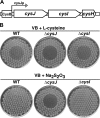
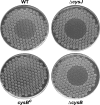
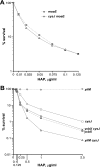
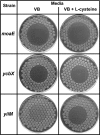

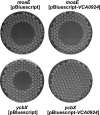
Comment in
-
The twists and turns of enzyme function.J Bacteriol. 2010 Apr;192(8):2023-5. doi: 10.1128/JB.00087-10. Epub 2010 Feb 12. J Bacteriol. 2010. PMID: 20154124 Free PMC article. No abstract available.
Similar articles
-
The twists and turns of enzyme function.J Bacteriol. 2010 Apr;192(8):2023-5. doi: 10.1128/JB.00087-10. Epub 2010 Feb 12. J Bacteriol. 2010. PMID: 20154124 Free PMC article. No abstract available.
-
TusA (YhhP) and IscS are required for molybdenum cofactor-dependent base-analog detoxification.Microbiologyopen. 2013 Oct;2(5):743-55. doi: 10.1002/mbo3.108. Epub 2013 Jul 29. Microbiologyopen. 2013. PMID: 23894086 Free PMC article.
-
YcbX and yiiM, two novel determinants for resistance of Escherichia coli to N-hydroxylated base analogues.Mol Microbiol. 2008 Apr;68(1):51-65. doi: 10.1111/j.1365-2958.2008.06128.x. Epub 2008 Feb 26. Mol Microbiol. 2008. PMID: 18312271 Free PMC article.
-
The pterin molybdenum cofactors.J Biol Chem. 1992 May 25;267(15):10199-202. J Biol Chem. 1992. PMID: 1587808 Review. No abstract available.
-
The regulation of Moco biosynthesis and molybdoenzyme gene expression by molybdenum and iron in bacteria.Metallomics. 2019 Oct 16;11(10):1602-1624. doi: 10.1039/c9mt00186g. Metallomics. 2019. PMID: 31517366 Review.
Cited by
-
Beyond Tryptophan Synthase: Identification of Genes That Contribute to Chlamydia trachomatis Survival during Gamma Interferon-Induced Persistence and Reactivation.Infect Immun. 2016 Sep 19;84(10):2791-801. doi: 10.1128/IAI.00356-16. Print 2016 Oct. Infect Immun. 2016. PMID: 27430273 Free PMC article.
-
Study of Ren, RexA, and RexB Functions Provides Insight Into the Complex Interaction Between Bacteriophage λ and Its Host, Escherichia coli.Phage (New Rochelle). 2022 Sep 1;3(3):153-164. doi: 10.1089/phage.2022.0020. Epub 2022 Sep 19. Phage (New Rochelle). 2022. PMID: 36204488 Free PMC article.
-
Study of Different Variants of Mo Enzyme crARC and the Interaction with Its Partners crCytb5-R and crCytb5-1.Int J Mol Sci. 2017 Mar 21;18(3):670. doi: 10.3390/ijms18030670. Int J Mol Sci. 2017. PMID: 28335548 Free PMC article.
-
Crystal structure of the hydroxylaminopurine resistance protein, YiiM, and its putative molybdenum cofactor-binding catalytic site.Sci Rep. 2018 Feb 19;8(1):3304. doi: 10.1038/s41598-018-21660-y. Sci Rep. 2018. PMID: 29459651 Free PMC article.
-
Comment on "A commensal strain of Staphylococcus epidermidis protects against skin neoplasia" by Nakatsuji et al.Sci Adv. 2019 Sep 11;5(9):eaaw3915. doi: 10.1126/sciadv.aaw3915. eCollection 2019 Sep. Sci Adv. 2019. PMID: 31535021 Free PMC article.
References
-
- Anantharaman, V., and L. Aravind. 2002. MOSC domains: ancient, predicted sulfur-carrier domains, present in diverse metal-sulfur cluster biosynthesis proteins including molybdenum cofactor sulfurases. FEMS Microbiol. Lett. 207:55-61. - PubMed
-
- Butland, G., J. M. Peregrín-Alvarez, J. Li, W. Yang, X. Yang, V. Canadien, A. Starostine, D. Richards, B. Beattie, N. Krogan, M. Davey, J. Parkinson, J. Greenblatt, and A. Emili. 2005. Interaction network containing conserved and essential protein complexes in Escherichia coli. Nature 433:531-537. - PubMed
-
- Clement, B., and T. Kunze. 1990. Hepatic microsomal N-hydroxylation of adenine to 6-N-hydroxylaminopurine. Biochem. Pharmacol. 39:925-933. - PubMed
Publication types
MeSH terms
Substances
Grants and funding
LinkOut - more resources
Full Text Sources
Medical
Molecular Biology Databases

